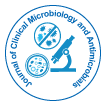
Journal of Clinical Microbiology and Antimicrobials
Open Access
+44-77-2385-9429

+44-77-2385-9429
Antibiotics, in one form or another, are in use for hundreds of years . The overwhelming majority of novel antibiotics are detected by screening of “wild isolates” obtained from soil and other natural habitats. Although a good taxonomic range of microbes have the power to supply antibiotics. Thus, over 55% of the antibiotics detected between 1945 and 1978 originated from the genus Streptomyces , representing a complete of quite 5,000 compounds 1.
With advances in chemistry many antibiotics are now also obtained by chemical synthesis, like the sulfa drugs. Drugs utilized in the chemotherapy of infectious diseases are classified into two groups. Drugs that are synthesized by chemical procedures within the laboratory are called synthetic drugs while those produced by bacteria and fungi are called antibiotics 2.
The antibiotics are cosmopolitan within the nature, where they play a crucial role in regulating the microbial population of soil, water, sewage, and compost.
Of the several hundred naturally produced antibiotics that are purified, only a couple of are sufficiently non-toxic to be of use in practice .
Those that are currently of greatest use have derived from a comparatively small group of microorganisms belonging to the genera Penicillium, Streptomyces, Cephalosporium, Micomonospora and Bacillus 3.
Antibiotics are low molecular-weight (non-protein) molecules produced as secondary metabolites, mainly by microorganisms that sleep in the soil. While many antibiotics are known to exist, efforts to get new antibiotics still continue. Therefore, many species like Streptomyces, Bacillus and Penicillium are studied continuously for his or her ability to supply antibiotics 4.
In addition, thanks to the very fact that Bacillus species have produced antibiotics within the soluble protein structure and that these antibiotics have been found to be cheaper and more effective in studies conducted to date, these microorganisms are preferable for commercial production.
Currently, the target is to supply antibiotics like polymyxin and bacitracin from Bacillus 5, 6. It was reported that members of the species Bacillus generally produced polypeptide type bacteriocines, and that these antibiotics generally affect Gram positive bacteria 7, 8. The apparent increase of the occurrence of antibiotic resistance among bacteria during the past years and its possible implication publicly health has led to an intensified surveillance of bacterial resistance in many countries.
Research: Journal of Clinical Microbiology and Antimicrobials
Research Article: Journal of Clinical Microbiology and Antimicrobials
Editorial: Journal of Clinical Microbiology and Antimicrobials
Editorial: Journal of Clinical Microbiology and Antimicrobials
Research Article: Journal of Clinical Microbiology and Antimicrobials
Posters & Accepted Abstracts: Applied Microbiology: Open Access
Poster Presentations: Journal of Antivirals & Antiretrovirals